Bad Power Factor? – A reason to oversize your inverter
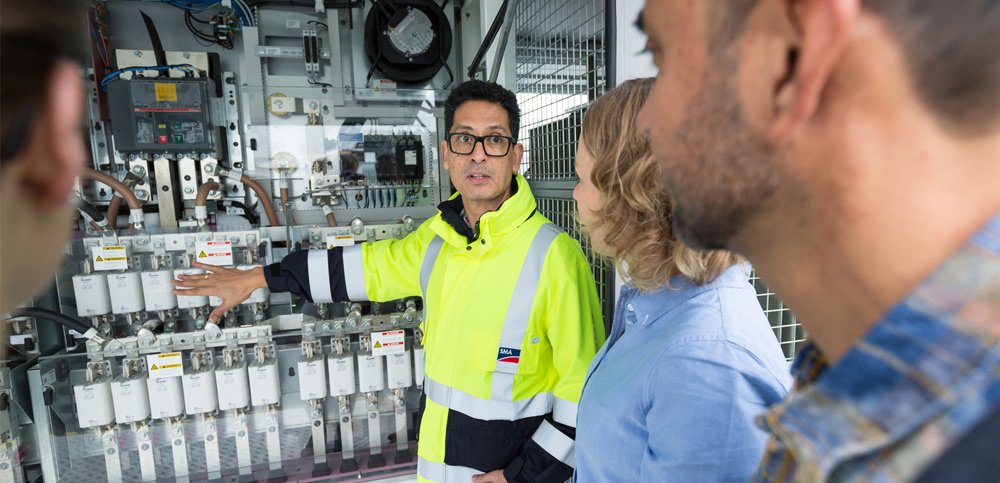
In a previous blog, we discussed some good reasons to oversize your PV array. In this blog we will discuss how, by oversizing your inverter, you can correct a site’s poor power factor.
Electricity used in our homes and businesses is (almost always) alternating current. Put simply, voltage and current that are transmitted throughout the electric power grid in a sinusoidal waveform averaging 0. When these current and voltage waveforms are perfectly synchronised in time, they have a power factor of 1 or pure active power.
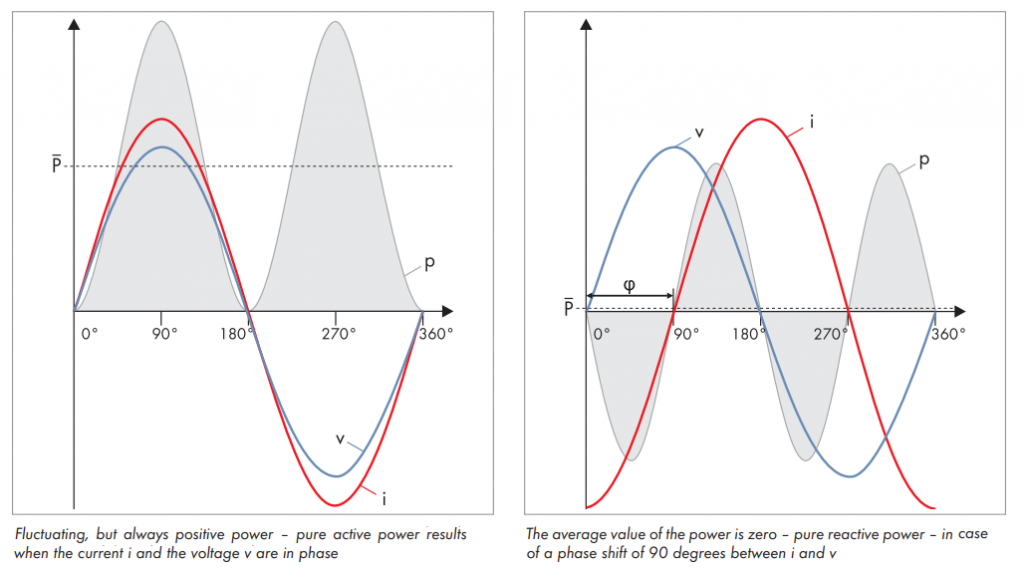
Example of pure active power (left) with current and voltage perfectly in-phase, and of pure reactive power (right) with current and voltage perfectly out-of-phase.
When we consume electricity (in pumps, fridges, lights, etc) current and voltage waveforms can go out of alignment. This will lead to a power factor ≠ 1. As a site’s power factor moves further away from 1, they will typically incur increased grid quality supply charges from their electricity provider. This is where your SMA inverter can begin to help save you even more money. By utilising SMA inverter’s built in grid support functionality, you can correct a bad power factor by feeding reactive power as well as active power and hence reduce the grid quality charge component of your electricity bill. This can often be cheaper than using additional power factor correction equipment such a capacitor banks. Often active power is just as valuable to a site as reactive power for correcting power factor. This creates a financial driver to oversize your inverter.
How much should I oversize my inverter?
Since this is an abstract concept for a lot of system designers and installers, let’s work through an example.
First, we need to understand the relationship between ACTIVE, REACTIVE and APPARENT power. Apparent power consist of active and reactive power, two different types of power existing only in its pure nature. Because active and reactive power don’t have a relationship, it is impossible to convert one power type to the other. A graphical model of such relationship is a cartesian coordinate system with active power for the x-axis and reactive power in the y-axis. These 3 power types are related together according to Pythagoras’ theorem as shown in the following diagram.
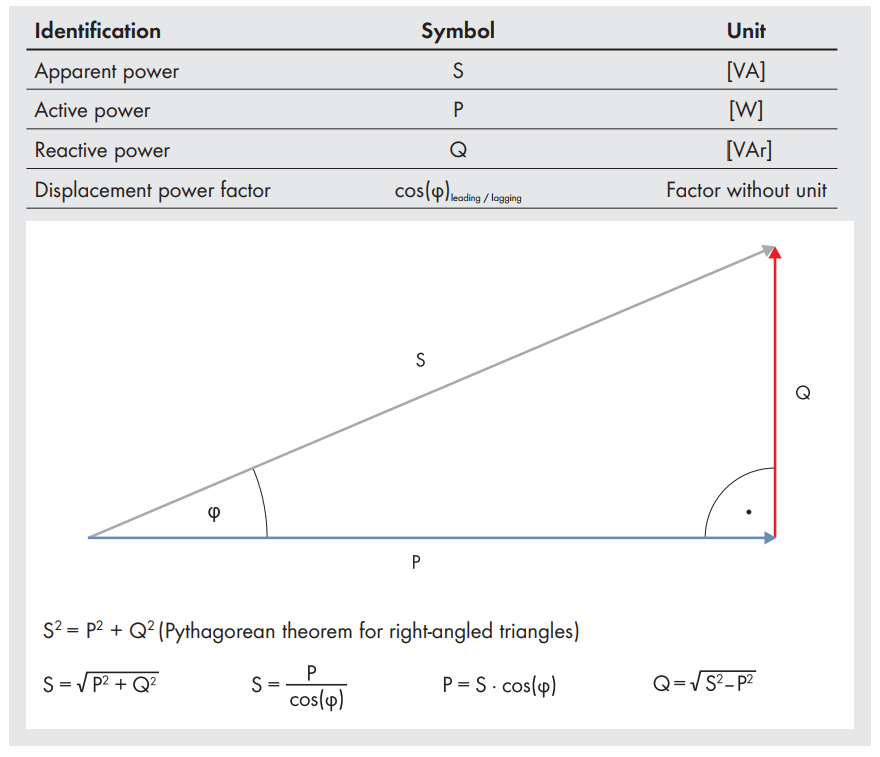
Relationship between Apparent, Active and Reactive power.
Now let’s assume we have a site which is consuming 80kW of active power with a site power factor of 0.85 due to some inductive loads such as pumps and motors. This would result in the following relationship:
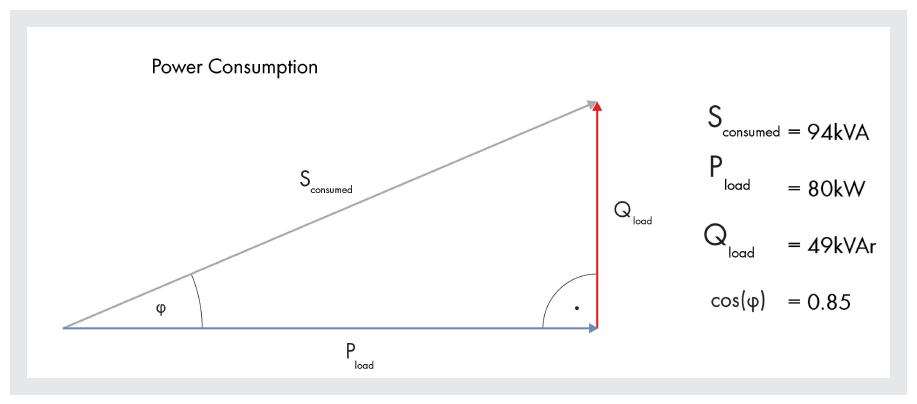
Power consumption without power factor correction or generation
Now let’s assume the site needs to correct its power factor back to 0.90, and they also want to reduce their active power consumption by ~60%. If we begin with a 60kW solar system (60kW PV array, 60kW inverter), and this system generated power with a cos(φ) of 1.0, we would have the following power consumption. We can see that if we did nothing to the way the solar system operated, it could actually make the site’s power factor (and hence power quality charges) significantly worse from the utility’s point of view.
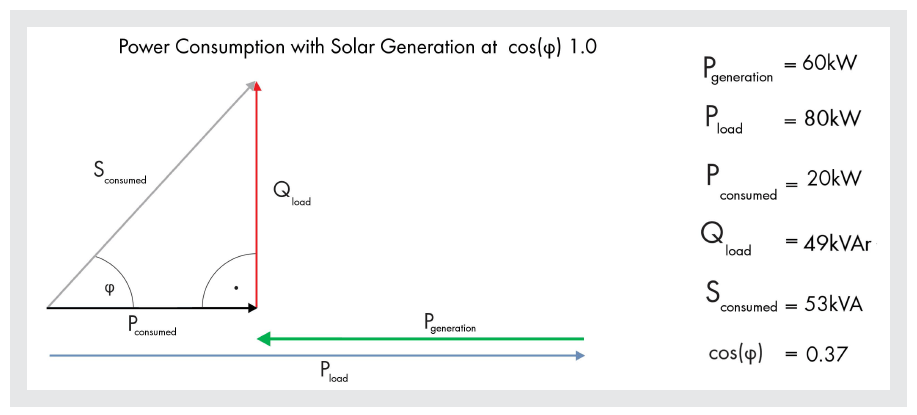
Power consumption with Generation at cosphi 1.0
Now let’s operate the solar system with a cos (φ) of 0.82 to try and correct the site’s power factor. We would have the following power consumption and generation relationships:
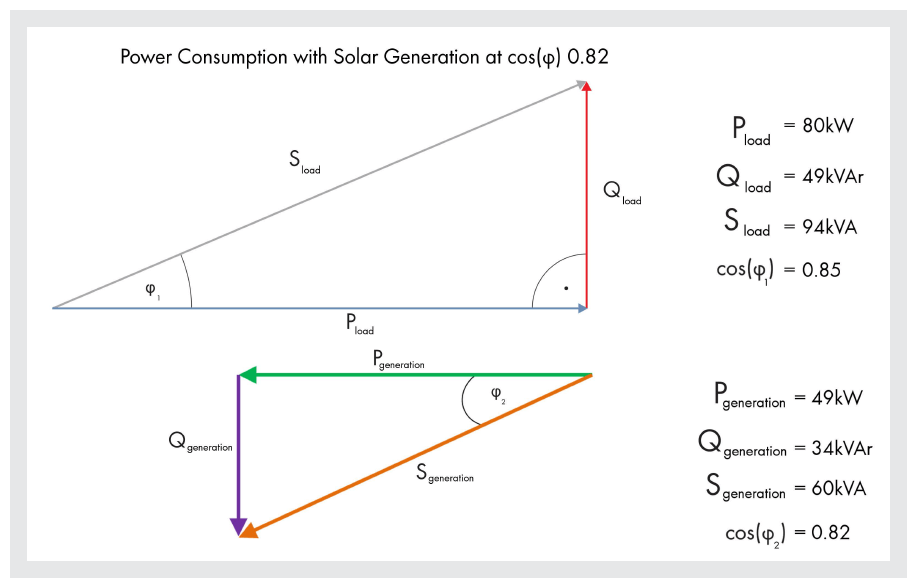
Power consumption with generation at cosphi 0.82
This would then have the resultant power consumption for the site according to the following:

Resultant power consumption with inverters correcting power factor
We could then consider to implement a cos(φ) function similar to the following could help to ensure that as the solar system increases its output power, it will change its cos(φ) to compensate for site power factor.
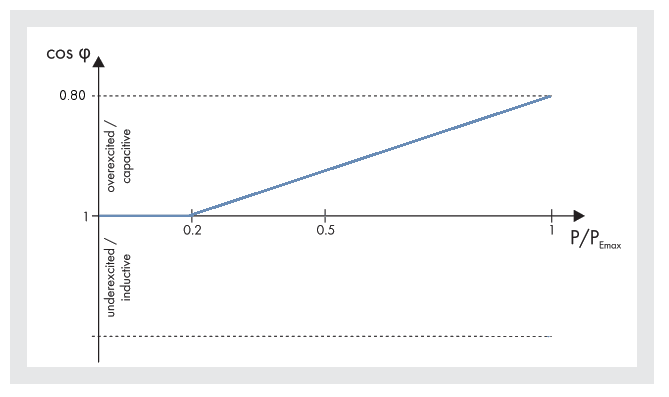
Dynamic cosphi function to assist correcting a poor site power factor
In this example, we require 60kVA of inverter capacity, but only 49kW of active power generation, meaning we can oversize our inverters by about 20% compared to the size of our PV array. SMA inverters can generate reactive power without using any active power. Within SMA, were refer to this capability as Q @ Night ( read more about Q @ Night here ).
Conclusion
By oversizing inverters, you have reserve reactive power capacity which can be utilised without sacrificing active power generation. Utilising the built-in grid support functionality in SMA inverters, such as a dynamic cos(φ) function, can help to improve a site’s power factor and in turn help to reduce grid quality supply charges a customer might incur from their electricity provider.
You can read more about this topic in detail by reading SMA’s PV Grid Integration technical compendium.

i have a inverter ,and a meter installed between in inverter and gird,but i find the grid power factor value from meter is negative, especially in night, so i am confused ,why occurs the value , because i think the power factor ranges from (0,1),when it is negative ,what does it indicate?
Hello well,
Please get back to our SMA Service for further support, thank you.
Sunny regards
Christiane
Hey my dear Keim,
Please i want to answer on my question about relation between power factor and directly load from panels(solar)
If i have an inverter without batteries and i want to use a load directly from solar to home
But the inverter gives me a error code 14
My question is : is there an inverter works wihtout batteries really? And what is the relation with power factor?
Hello Khaled,
Please contact our technical Service for further support, thank you.
Sunny regards
Christaine
Finally, how the inverter generates or absorbs reactive power at night? They use the DC link capacitor and with variation of output voltage they adjust to capacitive or inductive function?
did u get some solution, I am facing the same problem………where to place the CT with integrated systems of PV solar and utility. our system consumes 300KVA and solar panels provide only 200KW , the pf goes down specially when our utility is not consuming power
Hello Deepak,
Please contact our technical SMA Service for further support.
In your case, we need more detailed information.
For that, you may use our SMA Online Service Center.
The other option is that you get in touch with a local SMA contact.
If you wish to do that, please let us know the region you need support.
Kind regards
Christiane
I am trying to connect a distributed generator (17MW solar facility) to the regional distribution system. The utility has asked us to operate the facility at a suggested power factor of -0.89 (absorbing Vars) to help control system voltage. Can SMA’s inverters operate within this range? My question is will absorbing reactive power limit our facility’s real power output capability? (i.e., we are only compensated (paid) for real power delivered.) I understand that if we were asked to produce reactive power, this could sacrifice the amount of real power delivered, but want to ensure this is not the case when absorbing Vars. Thanks in advance for any advice you can provide.
Hello Kolja,
Please contact the SMA Service via our SMA Online Service Center for detailed technical support.
Thanks for understanding.
Sunny regards
Christiane
Ok, forgive me for asking, but what happens to a site’s PF at night time… let’s say you have a hotel or factory that runs almost constantly consuming reactive power at times the solar inverter is not producing anything…. if these people are billed based on their lowest PF at the highest KVA during each cycle, wouldn’t they still need a PFC to compensate for the reactive power requirements when the sun is down?
Hi Jim,
Sorry for the long delay in getting back to you.
The SMA Sunny Tripower has a feature called “Q@Night”. This feature (when enabled) allows the inverter to stay operating at night time and continue to provide reactive power according to the needs of the site. Q@Night is a feature unique to SMA inverters, and is used for exactly the situation you describe for controlling Power Factor. If the site needs to limit kVA drawn from the public grid, there are also options integrating batteries. These can be used in a “peak load shaving” so they only discharge their battery energy when it is required to keep the site below a limit.
Sunny regards
Christiane
We have installed a 290 kWp system in India (at a school ) using 9 SMA , STP 25000 TL-30 inverters. We also have replaced the power factor bank and supply all reactive power using the solar inverters. The power factor is expected to rise to at least 99%.
Thumbs up SMA , a deep dive in solar technology , now 7 years with SMA inverters . Thanks a lot
video of the school here : https://www.youtube.com/watch?v=Jl3x9_46jFQ
Thank you for your comment. That’s a really nice system! 🙂
Sunny regards,
Carolyn
Dear SMA professionals, regarding an ongoing project, I’ve got a couple of queries about your product. To maximize the PV array
Whether the inverter can set a fixed output PF, ie set a active power output cap?
With the fixed PF, can user apply oversizing on PV array, say 1.4 DC-AC ratio?
Can the inverter output or absorb Var without being affected by active power output fluctuation?
Can the inverter autonomously adjust the PF as grid requirement, saying normally operates with PF @ 1 and lowers the PF in response to grid Var demand?
Thanks!
Dear Alex,
Thanks for your questions.
Which inverter are your questions about? Just asking, because answers may differ based on the inverter, so please find below answers given based on common properties.
– Power output can be limited to a specified value. However, for further information (and additional devices and/or settings needed, if any), type of the inverter needs to be known.
– Yes. The upper limit for oversizing is determined according to the total working hours in maximum power per year based on the PV array configuration. This can (and must) be checked with our free design tool Sunny Design. As long as the inverter is calculated to work below 2400 h/year at maximum power, oversizing is allowed.
– In general, yes. However, for further information (and additional devices and/or settings needed, if any), type of the inverter needs to be known.
– Yes. It is possible to adjust the PF based on the grid requirements with a signal coming from the grid operator. However, for further information (and additional devices and/or settings needed, if any), type of the inverter needs to be known.
I hope this helps? You can also sign in our Online Service Center to get help.
Kind regards,
Anke
Hey Carolyn,
We have a residential PV site that we can see on our monitoring portal that the inverter turns on and off multiple times (3-6 times/15mins-60mins) throughout the day. Does bad power factor issues have anything to do with what this site is experiencing and causing the inverter to shut off? The site does have a pool/well pump and possibly motor equipment at the property. All DC and AC voltages/connections checked out fine every time we went out to check on the system. Can the pool/well pump or motors cause a spike in AC/DC voltage or AC/DC current to go beyond the inverters operating parameters for it to shut off and turn back on once those loads are off? Can you provide any insight as to what may be causing what this site is experiencing. Thanks!
A very insightful article. In this example as the load is inductive, the inverter delivers part of the reactive power (49 kVAR) to the load with the rest (15 kVAR) being sourced from the grid. The cos phi of generation is at 0.82. Can you please clarify if the PF setting of the inverter would be +0.82 (capacitive) or -0.82(inductive)?
Thanks for the explanation.
operating inverter not at unity power factor is good or bad in relation with cost?
by this concept kwh generation will reduce. so it will increase amount of bill for grid tied system but obvious oversizing 20% the inverter required of smaller rating (means lower the cost).
please correct me if i’m thinking in wrong way.
Hi Carolyn,
This is interesting but your instructions to set up the inverters in this manner could be improved greatly. To date we’ve have many discussions with SMA-Service teams and are still unable to determine which steps to take to set the inverter, or the controller, to have the system respond and correct power factor dynamically.
I have read these documents:
WP QATNIGHT.AEN132110W.pdf
Data Manager User Manual Version 2.1
Operating Manual CORE1 50kW Version 1.4
May you request that SMA HQ spends more time on providing sufficient instructions to your service offices and your clients? Thank you.
In this example, if we set the inverter to operate at 0.82 power factor, then we should oversize both the inverter and PV array, right?
Hi Jehad,
Thank you for your question. To provide addition reactive power only needs the inverter to be oversized. This is to allow all DC input energy to be used to generate kW, while still leaving a difference between the inverter’s kVA capacity and instantaneous kW output. This difference is able to be used to generate any required kVAr’s. The PV array does not need to be oversized, since oversizing would not increase reactive power capability.
Over sizing your PV array is only helpful to increase the generation of real power. You can read about that topic in a previous blog here.
Hope that answers your question.
Sunny regards,
Carolyn
Thank you Carolyn for your helpful answer.
Please, can I know in which mechanism does the inverter generates reactive power? In case there is no capacitor bank included inside the inverter!
Hi Carolyn,
I am currently working on a utility scale project and have a couple of questions regarding the inverter’s reactive power compensation. Is there someone I could email that can help answer my questions?
Hi Luqman,
I contacted you via email. 🙂
Sunny regrads,
Carolyn
Jehad hightlighted a correct statement:
S = P + jQ
S comes from PV arrays through inverter. If you increase Q, you will sacrify P. Thus, you need to increase S to maintain P incase you want to increase Q. Increase the inverter power rating is not the only solution.
In India there is harmonics, Power factor testing done by Electricity Company for grid connected systems.
And if the inverter capacity is 8 kW and array is 6 kW in residential case, there are more chances the harmonic is more than 5% and power factor less than 0.6.
Then Electricity company don’t give you approval..
For residential systems it is always better to have correct capacity of Inverter and pv array.
Even with SMA Inverter it happens.
Oversizing of Inverter maybe successful in Industrial application not for residential
Dear all,
Is the inverter reqd to be oversized ?In the case of inductive loads are more in a factory where in solar plant has been commissioned and connected to grid under net metering policy . The power factor has down than the stipulated level by utility and hence we are paying penalty to the utility on account of lower power factor.Can you please give some idea to improve the PF without any additional capital expenditure?
Hello Mr. Murugan,
Without having any information about your system we are not able to help you. Please contact your installer, he knows yout system the best. If he can not help you feel free to sign in on our Online Service Center.
Sunny regards,
Carolyn
are sunny boy inverter can produce Q at night ?
Hello Scott
The information given here is valuable. Please, can you be of help as to providing more informations or materials as to where i can get more knowledge as to increase my technical knowledge so as to convince commercial/industrial customers of this advantage and savings and so to secure more sales for my organization thereby increasing more sales of SMA products.
I’ve participated in an installation of a fuel-saving solutions for an oil lubricating plant here in my country using the STP 20000, but now I’m in a role that actively puts me in business development for commercial/industrial offerings. Informations given here will help a lot.
Best Regards
Adewale Bamgbade
Please contact SMA in you region. If you are contacting in Australia, please contact SolarAcademy@SMA-Australia.com.au
Hi Scott;
Thanks for the interesting article.
What if the inverter is not over sized?
Am I going to lose the extra input DC power in order to fulfill the grid requirement?
For STP60 Inverter, what is the procedure of setting the function of dynamic power factor
Very good illustrative presentation. However, i feel that over sizing inverter will not be required in some cases as the actual power generation of Solar PV arrays are often less than the name plate power due to factors like Temperature, irradiance, air flow rate etc.
Hi Scott
thanks for these valuable information.how and where can i get more info.so to increase my knowledge to convince commercial/industrial and domestic customers of this advantage and savings and so to secure more sales for ourselves and SMA products.
Regards
Farhad Khan
Hi Farhad,
we have contacted you directly about your request.
Kind regards,
Carolyn
Very informative and easy to understand article scott, thanks!
Interesting stuff. Reminds me of my uni power systems.
In future looking to reduce my electricity cost.
Regards
Ben
very interesting…